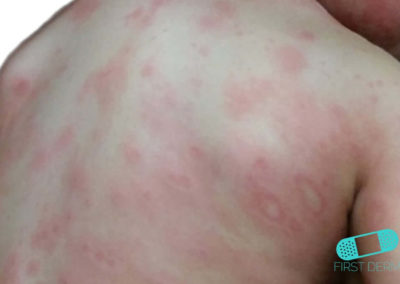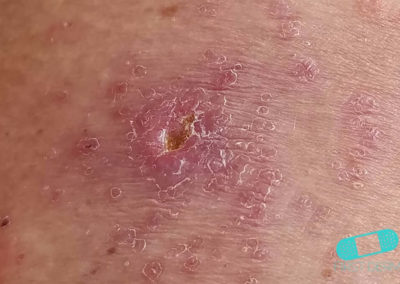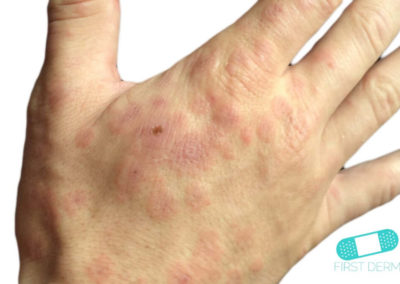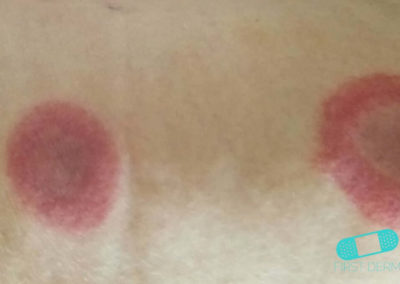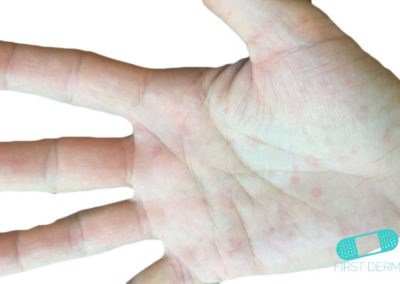Erythema Multiforme
Medically reviewed by The Dermatologists and written by Dr. Alexander Börve
Common
- Requires medical diagnosis
- Symptoms: Hive-like rash or circular blister pattern
- Color: Typically pink
- Location: On the upper body, legs, arms, palms, hands, feet, face or lips
- Treatment: No treatment necessary for minor cases; antibiotics for skin infections, corticosteroids, treatment in an intensive care or burn care unit and intravenous immunoglobulins for severe cases
ICD-10: L51.9
ICD-9: 695.10
Erythema multiforme (or EM) is a self-limited but recurring allergic reaction or infection. The exact cause of this skin condition is unknown, but is often associated with viral or bacterial infections or reactions to medication. It is most common in children and young adults.
Medicines that can cause this reaction include:
- Barbiturates
- Penicillins
- Phenytoin
- Sulfonamides
Precipitating factors include herpes simplex virus (HSV), mycoplasma, Epstein-Barr virus (EBV), and histoplasmosis. Most affected individuals experience 1-2 recurrences per year.
Try our FREE dermatology search engine and get peace of mind within a second
Symptoms
Erythema multiforme usually presents as a pink, hive-like rash or circular blister pattern like a target. You may also experience fever, itchiness, and aches. Dry eyes, mouth sores, and vision problems are less common symptoms.
With that being said, there is a wide spectrum of symptoms and severity from mild to extreme.
Minor forms of erythema multiforme presents a localized eruption of the skin. The small pimple-like rashes then evolve into larger lesions within 3 days and lasts in the affected area for at least 7 days. They often have a central sore surrounded by pale red rings. They usually locate on the upper body, legs, arms, palms, hands, feet, face or lips. The lesions will then heal on its own.
Major forms of erythema multiforme, considered by Stevens-Johnson syndrome by some clinicians, are potentially life-threatening. The lesions are irregular and typically begin on the face and trunk. You may also have blistering. More than 50% of all cases are attributed to medications.
Try our FREE dermatology search engine and get peace of mind within a second
What can I do?
You can try controlling the illness that is causing the condition and use moist compresses. Good hygiene and staying away from other people may help prevent secondary infections.
Should I seek medical care?
Most erythema multiforme disappears within 7-10 days, but the problem may return. As always, a dermatologist should be consulted if this concern does not resolve itself or gets worse. Most doctors can diagnose the problem by looking at your skin.
Treatment
No treatment is necessary for erythema multiforme minor. Antihistamines can relieve itchiness, while antiviral medicine and antibiotics can control infection. Topical anesthetics can ease discomfort that interferes with eating and drinking.
Treatment of severe symptoms include antibiotics for skin infections, corticosteroids, treatment in an intensive care or burn care unit, and also intravenous immunoglobulins (IVIG, an injection of healthy cells from donors into a vein).
Try our FREE dermatology search engine and get peace of mind within a second
Source:
Jose A Plaza, MD. Erythema multiforme. Available at: http://emedicine.medscape.com/article/1122915-overview
U.S. National Library of Medicine. Erythema multiforme. Available at: https://www.nlm.nih.gov/medlineplus/ency/article/000851.htm
Ask a Dermatologist Now
Anonymous, fast and secure!

The Specialist doctor from the University Hospital in Gothenburg, alumnus UC Berkeley. My doctoral dissertation is about Digital Health and I have published 5 scientific articles in teledermatology and artificial intelligence and others.
